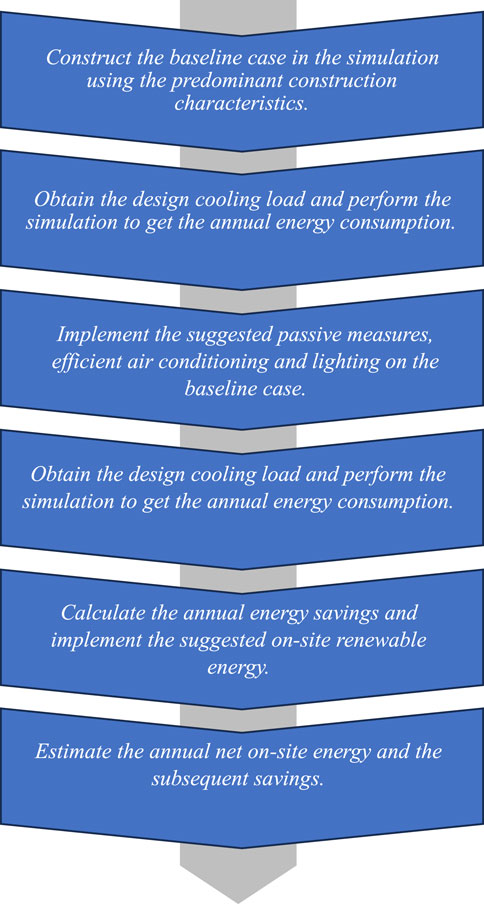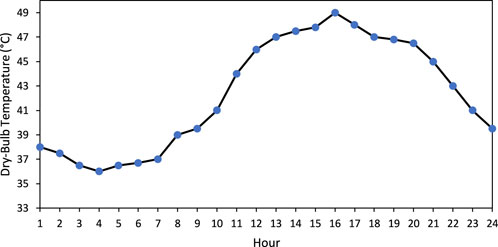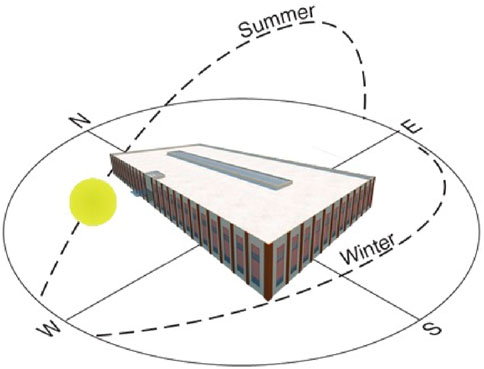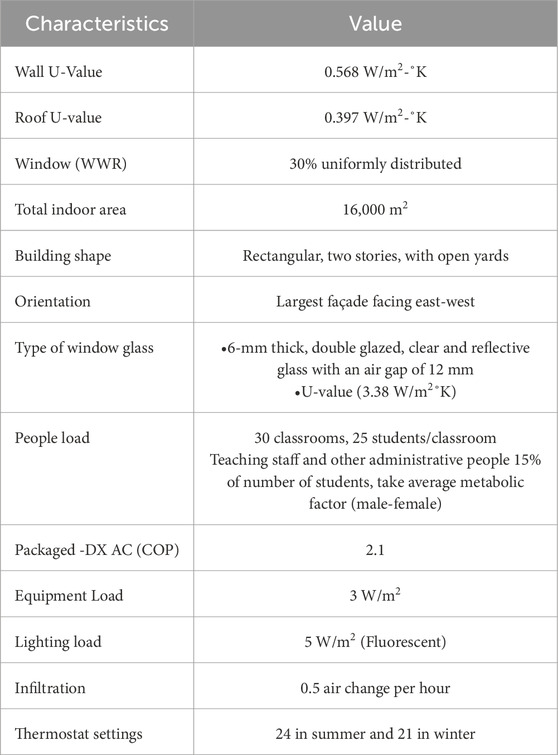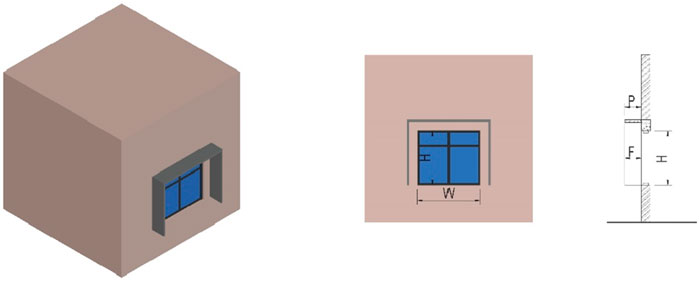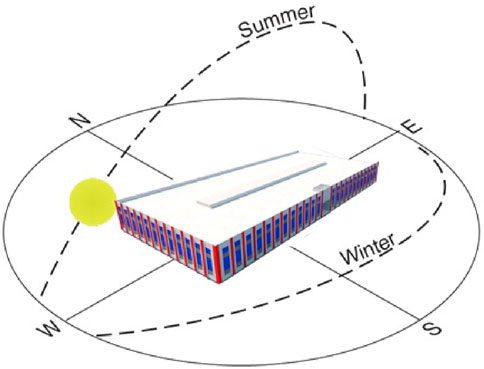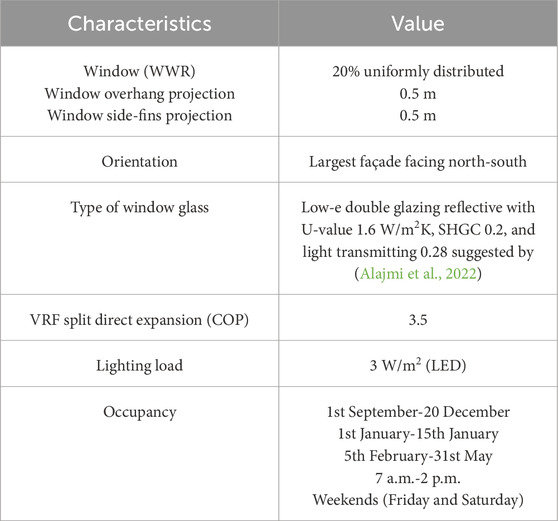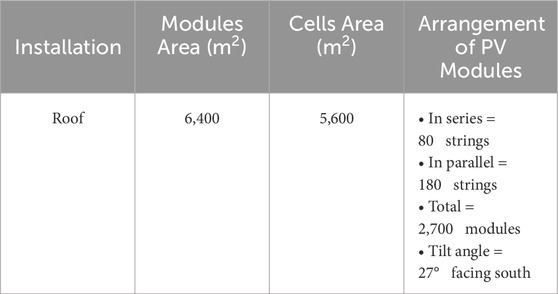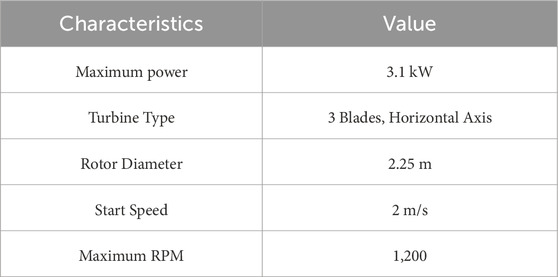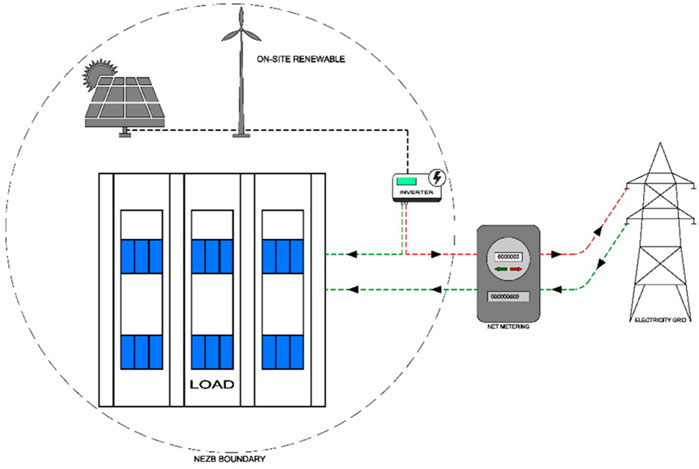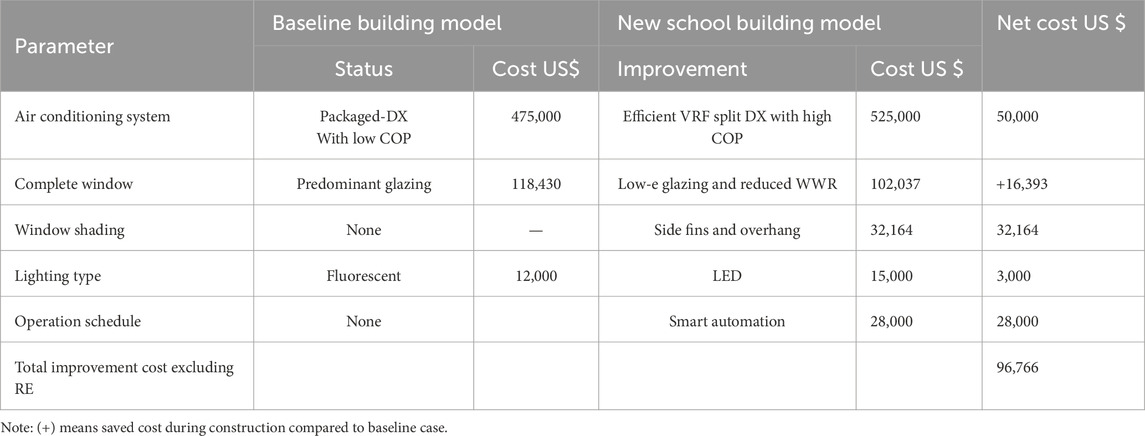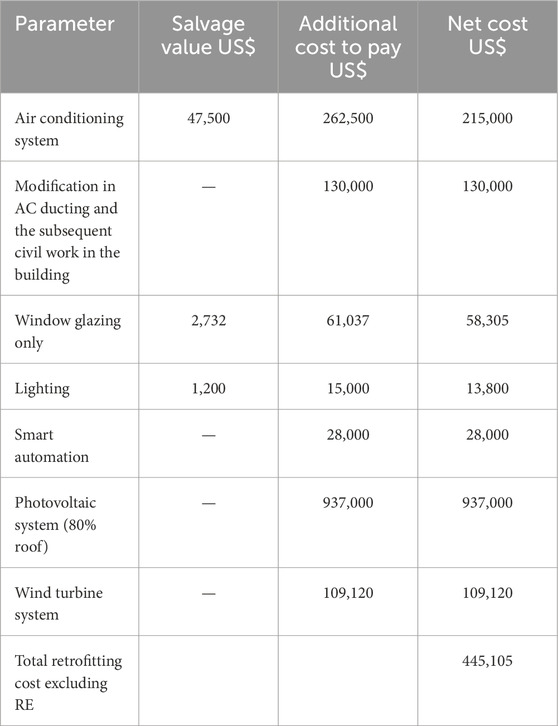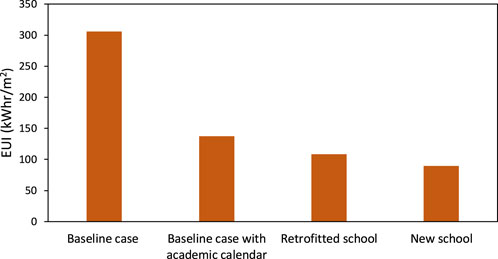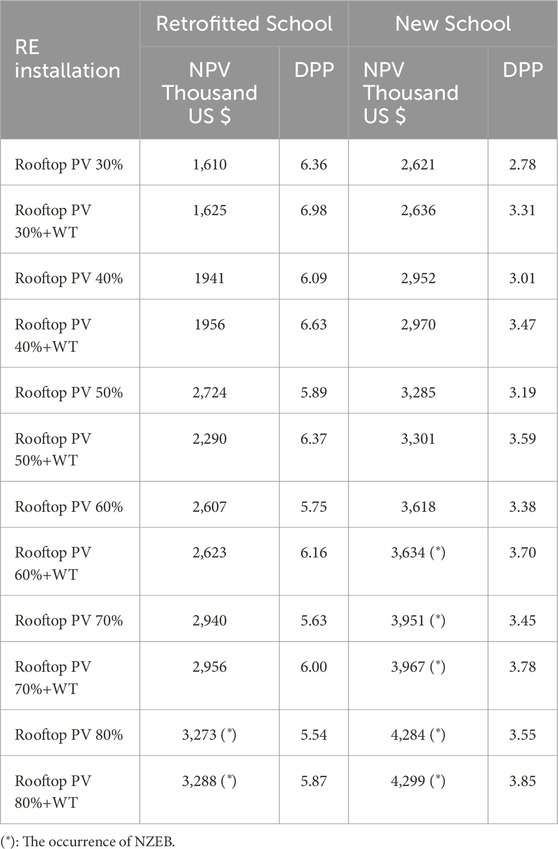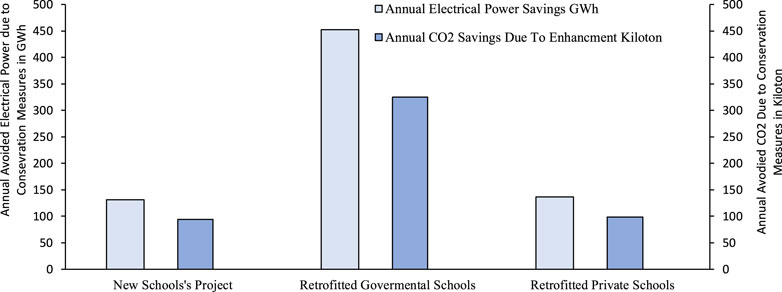- Department of Mechanical Power and Refrigeration Technology, College of Technological Studies, PAAET, Kuwait City, Kuwait
It is commonly known that buildings in hot climate contribute to a huge amount of electricity consumption mainly due to air conditioning needs. Many countries around the world are aiming to convert buildings to net zero energy buildings (NZEB). However, buildings in hot climates require varieties of active and passive measures to adapt the concepts behind NZEB. This work attempts to resolve the challenges associated with shifting school buildings to NZEB in hot arid climates. It presents an energy performance analysis that is focused on two scenarios for new and retrofitted schools. Building thermal simulation is used to assess the implications of several energy conservation measures, and different scenarios are suggested to utilize up to 80% of roof’s area for the installation of Photovoltaics (PV), and on-site wind turbines. The implemented energy conservation measures show a reduction in annual energy consumption by 35% and 21% for new and retrofitted schools respectively. Discounted payback period is used to estimate the economic feasibility of the suggested scenarios. It is found that NZEB is technically feasible at highest roof area PV installations with respective discounted paybacks of 3.55 and 5.54 years for the new and retrofitted schools. However, adding wind-turbines can delay the breakeven year of investments needed to achieve NZEB. The estimated savings in net present value (NPV) are 3273 and 4284 thousand US dollars for the retrofitted and new schools respectively, and each school’s roof can generate 40.63 GWh in 25 years and avoid 29.23 kilotons of CO2.
1 Introduction
The rapid growth in world energy usage has already raised concerns about the ability to continue in the same energy consumption patterns, considering the exhaustion of nonrenewable energy resources. This has also led to a significant increase in greenhouse gas emissions (GHG), mostly from power generation (Pervez et al., 2021). The historical trends on global energy demand have shown that it generally rises with the expansion of urbanization and modernization in countries, in addition to the increase in human population (Webb et al., 2017). The breakdown of global energy consumption has shown that building energy consumption accounts for about 40% of annual primary energy in developed countries and about 20% of annual primary energy resources in developing countries (Li et al., 2015). There is special consideration to studies of net-zero energy buildings (NZEB). This approach means that buildings can generate an amount of energy equal to that consumed on an annual basis (Sartori et al., 2012). It covers promising improvements in construction and occupant behaviors known as efficient control measures toward controlling energy demand around the world particularly in developing countries (Valasai et al., 2017; Yousuf et al., 2014). The NZEB also targets maximizing the generation of renewable energy in the building (Ahmed et al., 2022). In general, the concept behind an NZEB can be reached by three approaches, first by reducing energy usage through passive strategies, second by applying energy efficient technologies, and third by allowing the building to maximize its potential to generate energy from renewable resources.
There are varieties of technical, financial, and environmental considerations that must be addressed before considering the potential approach. Harkouss et al. (2018a) explained that there is no common approach for a NZEB, and the final achievements rely particularly on the applicable approach to follow. Furthermore, the scientific community encourages buildings that are nearly NZEB (nNZEB); which is another optimistic contribution in this field (Wells et al., 2018). The European Union, through the Energy Performance of Buildings Directive (Directive, 2010), defined nNZEB as buildings with very high energy performance. From this understanding, it seems that controlling buildings’ energy demands under NZEB concepts is promising for decision-makers and designers. The present work provides a systematic approach to the potential of converting schools to NZEB in hot climate. The presented work capitalizes from the recent improvements in building thermal simulation tools to estimate the performance of school building in Kuwait, and to give insights to the benefits that can be acquired after achieving NZEB balance. This can help planners and energy policymakers to integrate performative aspects in early design stages.
1.1 Background
The wide spread of NZEB focuses more on employing passive-designing techniques as an essential step towards lowering energy consumption. It is a well-known strategic decision in building construction. The passive measures include insulation, building orientation, natural ventilation, daylighting, and phase change material (Rana et al., 2021; Singh, 2018; Stephens, 2011; Hutton, 2012). The effectiveness of passive techniques should be suitable to the site of the building, especially to the climate conditions. Johnston and Gibson (Johnston and Gibson, 2010) indicated that proper site analysis and climate conditions are the primary steps in designing NZEB. Gorse (2020) suggested that there is no common rule or specific consideration of passive design for all regions around the world, and energy-efficient building codes and regulations should be applied with respect to the nature of climate conditions.
On the other hand, applying efficient technologies is another approach in NZEB. It is concerned with embedded systems that consume less energy than conventional technologies. This approach covers heating, ventilation, air conditioning systems (HVAC), domestic hot water (DHW), lighting, and appliances. The approach also targets smart control of the technologies as well as managing the behavior of the end users. Awareness from building design professionals, contractors, and owners, is a key principle for adopting efficient technologies in NZEB (Anju, 2017). Adopting efficient technologies can considerably affect the energy requirement of the building; especially with the help of building automation and control (Aelenei et al., 2013). The reduction in energy consumption from passive design, in addition to implementing efficient technologies in the building, represents an inspiring step to tie the building to renewable energy sources. In this context, connecting the building to renewable energy generation systems represents the last approach in NZEB, and the common renewable technologies are Photovoltaic (PV), wind turbines, and solar collectors.
The worldwide rapid development in the energy sector forced countries to look at their energy scenario with special emphasis on major consumers like buildings. The European Union, as an example, has set a definition of the efficient buildings, considering France as an example, where the national legislation specified nNZEB for residential and office buildings (Paoletti et al., 2017). The European Union countries are also obliged in a long-term strategy to convert existing and new buildings, including public, private, residential, and non-residential buildings to an appropriate level of nearly zero energy buildings (nNZEB) by 2050 (Directive, 2018).
The performance of efficient buildings in terms of energy usage is classified according to the annual energy use intensity (EUI) measured in kWh/m2 (Kurnitski et al., 2014). In contrast, many countries are not giving the desired response to this issue. Countries that have hot and arid climate conditions in the Middle East, for example, rely mostly on fossil fuels to supply electricity to buildings (Al-Saeed and Ahmed, 2018). Hot climate conditions are common features of countries in this region, and it is commonly known that buildings in hot climates receive severe solar irradiances that strike building envelopes and windows, especially at the west façade (Almutairi, 2012). This raises the cooling load, which adds a burden on air conditioning systems and subsequently consumes more electrical power.
From the NZEB point of view concerning weather, Pless et al. (2014) indicated that weather conditions influence buildings’ energy consumption; as well as renewable energy resources; and an NZEB might not be achieved every year. An investigation was conducted to study 34 worldwide cases on NZEB by Feng et al. (2019). They recommended that implementing NZEB in hot climates is significant, which raises the necessity to integrate passive design, energy-efficient systems, and renewable energy technologies. Accordingly, implementing NZEB or nearly NZEB (nNZEB) is essential in countries that lack intensive care from governments, especially with highly subsidized electricity, as in the Middle East region. Research is being carried out in the literature to reduce building energy consumption in various countries in the Middle East (GamalEldine and Corvacho, 2022; Krarti et al., 2017; Krarti and Dubey, 2017; Park et al., 2019; Ali and Hashlamun, 2019). However, legislative regulations still did not reach the level of the example from the European Union. Kuwait is a good example of countries from the Middle East (Gulf State), which suffers from a rapid increase in electrical energy demand due to building air conditioning (Almutairi et al., 2015). The country implements a building energy code (Ministry of Electricity and Water of Kuwait, 2019) that stimulates building designers and owners to make their buildings efficient, but unfortunately not to the level of NZEB or nNZEB. Furthermore, (EUI) is not measured and not addressed by the energy code, which subsequently resulted in complete disregard for this important evaluation parameter.
Concerning the NZEB concept, a study was conducted by AlAjmi et al. (2016a) to verify the potential of NZEB for an existing educational building in Kuwait that is cooled by a chilled water system. They studied three scenarios, first, using PV modules in the entire roof’s area, second, replacing the current chillers with more efficient chillers, and third using the roof area to combine PV modules with a solar absorption chiller. They suggested that implementing energy efficiency measures by using more efficient chillers, in addition to utilizing the roof’s area to occupy PV solar modules, can result in saving electrical power and avoid CO2 emissions, which can promisingly reach NZEB in a monthly basis in few months only, and nNZEB in an annual basis. They also recommended that dealing with an existing building to be converted to NZEB is much harder than implementing the applicable NZEB approaches for new buildings. They also stated that ‘most of the literature work for NZEBs is focused on dwellings and/or newly designed buildings, whereas existing commercial and institutional buildings have received little attention particularly in hot climate’.
Implementing the concept of NZEB in a similar climate in Gulf Cooperation Council (GCC) countries was successfully reached in a study conducted in the United Arab Emirates (Alkhateeb and Abu-Hijleh, 2019). They concluded that the passive measures could reduce electricity by 14.7%, while the active measures could reduce electricity by 63%; and they emphasized the importance of protecting glazing from solar radiation, especially with large windows. The impact of various solar shading techniques in a hot arid climate with efficient glazing was present in a recent study that investigated various glazing types and shading schemes (Alajmi et al., 2022). The authors examined the economic feasibility of efficient glazing and shading compared to the current practice with the predominant glazing type and construction style for houses in Kuwait. The study found that building energy consumption using low-performance windows is higher by about 6 times than that using high-performance windows, significantly at higher window-wall-ratio (WWR). However, this significant saving due to efficient glazing and shading was achieved in accordance with the fixed thermal resistance of walls and the roof.
The impact of reducing heat gain through the building’s envelope using an exterior insulation finish system (EIFS) was investigated by Al-Awadi et al. (2022). They investigated four types of building envelope walls for common residential building construction in Kuwait considering the heat gain from thermal bridging in the envelope’s external walls and roof. It was found that adding EIFS to walls and roofs can significantly reduce heat gain through the building envelope and subsequently lower energy consumption. Most of the studies in this region focused on residential buildings due to their large share of electrical energy consumption. The problem with residential buildings is that they are almost occupied around the year, and they must be air-conditioned continuously in the long summer months, as found by Al-Temeemi (1995). So, it might not be a promising solution to convert residential buildings to NZEB; which are large in number and almost occupied during summer. The occupancy period has been a significant influencer that forced building owners to let air conditioning operate to maintain the desired thermal comfort. In this context, school buildings have a long summer holiday, and the common practice is these buildings have no occupants during that time and do not require usage of energy. No previous attempts have been made to quantify the energy savings that can be acquired by incorporating efficient passive techniques and low-energy solutions to enable such buildings like schools in Kuwait to play an important role in this regard. Thus, a notable gap in the literature is identified, specifically for school buildings in the region. With the absence of compulsory NZEB or nNZEB in the region, this work aims to examine the viability of school buildings to meet the requirements of NZEB in hot climate.
1.2 Aims of this study
The present study considers the theme of the work in two parallel directions. First, by studying the existing school’s building model, which represents the predominant construction style in Kuwait, and verifying its ability to adapt NZEB under a retrofitting scheme. Second, suggesting comprehensive enhancement measures and technologies to enable the new schools to act better towards NZEB. The country is planning to build residential cities in the next 10 years, such as Sabah Alhmad City, where the number of new schools is 170, while the number of existing schools are 979 governmental schools, and 296 private schools (Public Authority for Housing Welfare in Kuwait, personal communication, 2023, September 10).
Estimating the energy performance of school buildings to act actively as efficient buildings seeking NZEB has not yet been investigated in the literature in Kuwait. For this reason, a computer model that represents the common school type in Kuwait was created by DesignBuilder Thermal Building Simulation. Three cases for the analysis were made, the first case is a school building that meets the requirements of the energy code in Kuwait, which barely meets the standard of the code with complete disregard to efficient passive energy solutions, efficient HVAC, and low energy consumption lighting. The second case incorporates improvements to enhance the building’s thermal performance and the subsequent energy savings. The second case herein represents the possible retrofitting that can be made to enable the building to meet NZEB. Finally, the third case represents the new school to be built in the future, which has extra improvements to meet NZEB more effectively compared to the retrofitting case.
The concept of NZEB is predominantly considered in accordance with annual energy balance, welcoming the exchange with the relevant utility grid due to energy storage constraints. For this reason, this work views its results, on an annual basis, considering the relevant school’s academic calendar. Hence, the contribution of this work can be summarized as the following.
• Reducing the school building’s electrical load by installing window’s overhang and side fins, efficient glazing type specified by Alajmi et al. (2022), positioning the largest façade to the north-south direction for the new schools, implying efficient air conditioning, and an efficient lighting system.
• Installing the appropriate PV modules and wind energy to assist the grid, where the generation source is from the building roof and its vacant yard.
• An economical evaluation of the saving annual energy consumption due to the suggested modifications.
• Estimating the avoided CO2 from applying the recommended solutions compared to the baseline case.
2 Research methodology and material
This work aims to estimate the applicability of suggested energy savings solutions on the current construction style of schools in Kuwait. The proposed solutions are examined by Thermal-Building Simulation to measure the tendency of schools to perform efficiently in terms of saving energy and producing on-site energy from renewable energy alternatives. An overview of the methodology flow chart is shown in Figure 1. More details about the specific inputs penetrated in the simulation and other relevant materials are illustrated in the following subsections.
2.1 Climate region and weather conditions
Kuwait is a hot-climate country in the Arabian Gulf that has harsh climate conditions that average 48°C DBT and 50% RH, which require running AC systems from April through October. Al-Mutairi et al. (2011) indicated that air conditioning accounts for approximately 70% of the country’s annual peak load and 45% of the total annual electricity consumption. Buildings in Kuwait receive substantial solar irradiances which can reach about 950 W/m2 daily on a horizontal surface during summer (Allison, 1979). Figure 2 shows the variation of dry bulb temperature on a hot summer day in Kuwait (DesignBuilder Software Ltd, 2023).
2.2 Description of the studied school building
The studied building represents the common schools in Kuwait with two stories and a total floor area of 16,000 m2. The building geometry is of a rectangular plan, but the current schools in Kuwait are built with complete disregard for the optimum directional orientation. For this reason, the baseline case is assumed to be built based on the assumption that the long two sides of the school building face an east-west orientation, as shown in Figure 3.
Typical schools of this indoor floor area can occupy up to 900 people 5 days a week on the specified occupancy schedule to be penetrated in the simulation with a continuous summer vacation from 1st June until 31st August annually.
The school’s walls and roof are designed in accordance with common construction patterns, which are compatible with the energy code of practice implanted by the government in Kuwait. The wall and roof layers are classified as a heavy thermal mass, with an overall heat transfer coefficient of 0.562 W/m2 K and 0.397 W/m2 K, respectively. The energy code of practice specifies the overall heat transfer coefficient of the roof after insulation to be 0.187 W/m2 K with medium thermal mass.
The openings of the buildings (windows and entrance doors) are made of aluminum with a framed structure comprised of 6 mm double glazing with an air gap of 12 mm and an overall heat transfer coefficient of 3.38 W/m2 K. The selected air conditioning system for the baseline case is a roof-top packaged-direct expansion air conditioning system with a COP of 2.1 in accordance with the minimum COP specified by the code. The selection of this air conditioning type is based on our observation from typical schools in Kuwait despite their low efficiency in conserving electrical energy. The building’s characteristics are summarized in Table 1.
2.3 Validating the simulated school building
The building is simulated using the popular DOE EnergyPlus simulation engine through its interface with DesignBuilder. The baseline case represents the typical school building considering all input data needed in the simulation. The input data covers the location to consider the local weather, geometry and orientation, construction characteristics, lighting, equipment and HVAC, occupancy period and people load. The simulated building model has been validated based on energy use intensity (EUI). The calculated EUI of the studied baseline building model was about 308 kW/m2. The international standard indicated that EUI for public and commercial buildings may range between 254- and 352-kW h/m2 (EIA, 2003).
Measuring EUI represents to what extent the building is conforming to the related energy standard in terms of energy consumption. The status of this measurement in Kuwait is not yet being popularized. However, in a study conducted by AlAjmi et al. (2016b) they investigated the energy use intensity for an educational building in Kuwait. The EUI was measured experimentally in 12 months, and they found that the measured EUI was about 348 kWh/m2. This high EUI was attributed to the inefficiency of energy consumption and other related factors that might affect the EUI. On the other hand, the calculated EUI in the present study is based on simulating the baseline case with respect to specific input data specified by the applied Energy Code in Kuwait, and without implementing the academic calendar that requires smart automation of the school’s energy usage.
2.4 Suggested passive measures, efficient technologies and operation strategy
The necessary elements for the successful development and operation of NZEBs consist of applying design-based passive energy solutions, smart automation with sensors and actuators, integrated control of the building, and subsystems for the operation of the building (Kolokotsa et al., 2011). The passive approach as an example has a a direct effect on cooling, heating, lighting, and ventilation loads dependent on what kind of energy saving the designer is looking for. So, from a fundamental point of view, this work prefers to manipulate the building envelope with some features that can lower the annual energy consumption, particularly from solar irradiances. It is preferred to amend the predominate construction style presented by the baseline case model with a few parameters of the initial design including the window-to-wall ratio, windows side-fins, overhang projection, and window glazing (Figure 4), and directional orientation (Figure 5). The mentioned parameters are expected to passively lower the energy demand, as indicated by Harkouss et al. (2018b). Some of the considered parameters are applied to new schools only.
Passive design solutions can make significant contributions to reducing the energy demand of the building if they are combined with energy-efficient equipment. The study recommends changing the current air conditioning systems (rooftop direct-expansion AC) and fluorescent lighting, which are both commonly used in school buildings in Kuwait. The recommended substitutes are variable refrigerant flow (VRF) split air conditioning systems and light-emitting diode (LED) lighting with lower power intensity. VRF split system has the potential to lower electrical energy requirements associated with rooftop packaged direct expansion as indicated by Alajmi and Zedan (2020). Also, LED lighting is a good saver for electrical energy compared to fluorescent lighting (Espejel-Blanco et al., 2018). On the other hand, the work also covers the appropriate operation scheme for the school building to enhance the energy-saving strategy that comes before NZEB. AlAjmi et al. (2016b) in the work discussed earlier, found that improper operation schedule for air conditioning and lighting during weekends and holidays has a significant impact on the resulting high EUI value. From this understanding, the current work suggests adding the operation schedule that matches the academic calendar as an additional parameter in the amended simulation model. The intended outcomes from the performed enhancement are measured in terms of EUI. Table 2 summarizes the additional enhancement parameters included in the modified building model.
2.5 Suggested on-site renewable energy production
The potential of net zero energy building approach relies on the ability to adopt renewable energy alternatives in addition to as much reduction in energy demand of the building. So, the annual net balance could be achievable between the total energy consumption and the available total on-site energy generation by renewable energy alternatives. From this concept, incorporating renewable energy is more effective at the design stage to meet energy requirements. Accordingly, the current work examines two renewable energy sources to generate electrical power measured on an annual basis. The analysis is performed using the renewable energy capabilities in DesignBuilder software and the suggested sources are rooftop photovoltaic solar cells and on-site wind turbines.
The capacity of renewable energy design calculations is dependent on the remaining energy demand that results from the incorporated passive measures and efficient technologies that were discussed in Section 2.3. The proposed installation area for the rooftop solar modules is estimated to reach about 80% of the roof’s area, keeping 20% of the roof free for shading effect and maintenance. Another possible installation area is the open yards inside the school’s fences. The predicted performance of PV modules tilted on the roof is based on the hourly solar irradiance of Wh/m2 from the TMY file in DesignBuilder. The electrical power generated from the proposed PV installation in the simulation is based on si-mono model CS3U-380M at 27° tilt angle facing south, which has a nameplate capacity of 380 W, with an efficiency factor of 19.1% and an inverter efficiency of 98.1% (Almutairi et al., 2022). The arrangement of PV modules is shown in Table 3.
For the wind energy source, an experimental study was conducted in desert area in Kuwait to examine the feasibility generating electrical power from wind turbines compared to PV power plant in the same location (Al-Nassar et al., 2021). They found that wind turbines farm outperforms PV plant by 20% more electrical power generation in an annual basis with more cost effectiveness. However, the current work finds it difficult to benchmark with this work because these plants are operated in desert area, where the location is 280 m above sea level, and dust storms significantly affected the performance of PV panels. The current study is concerned with on-site power generation to satisfy the building electrical load. So, this work examines the feasibility of wind turbines to take a share of on-site renewable energy generation for the school’s studied building.
Wind energy from wind turbines is based on a minimum distance of 3-5D (RESDM, 2023). The suggested turbine distribution is designed to keep space equal to 4 times the diameter of the turbine to avoid any aerodynamic interference. The uncertainty behind selecting wind turbine as an alternative to PV is generally due to the high installation cost of wind turbines. For this purpose, a total number of 16 wind turbines are suggested to be installed on the roof of the school building in 2 rows, 8 in each row, where the estimated utilized area resulting from the distribution is about 350 m2, which represents about 4% of the roof’s area. The suggested wind turbines are assumed to be installed on a 10 m high pole, where the micro wind environment has been neglected in the simulation performed by DesignBuilder software. Characteristics of the wind turbine are given in Table 4 (Zeus, 2023). Figure 6 illustrates the suggested renewable energy sources on the school building’s roof. From the figure, any excess electricity consumption from the utility grid or production of electricity from renewables is measured according to a net meter. So, no energy storage is proposed in the undertaken analysis.
2.6 NZEB equations and performance formulas
Energy consumption of the school building relies on various parameters necessary for the calculations. It comprises energy consumption resulting from air conditioning, appliances, and lighting. Also, the calculations expand to consider renewable energy sources used to produce the on-site energy. Solar energy harvesting through photovoltaic modules to be installed on the school’s roof and in open yards if needed to meet energy demand on an annual basis, with the ability to send surplus electricity, if exists, to the grid.
This work is based on the definition of NZEB illustrated earlier in the introduction, yet the uncertainty behind achieving NZEB shall be verified in accordance with the resulting energy balance between building energy demand and on-site energy production by renewable energy resources. Net energy needs of the school building on an annual basis are calculated according to Equation 1, and the resulting amount should equal 0 kWh (annually) for successful NZEB.
Where
2.7 Method of economic and environmental evaluation
The school’s owner during the design and construction stages should be aware of the impact of enhancement decisions from a financial point of view. Based on that, there are additional costs that should be paid if the owner (the government in this case) decides to undertake the suggested enhancements. The costs herein cover better window glazing type (CGlz) with smaller WWR, installing overhang and side fins (CProj), installing VRF split direct-expansion system (CAC), LED lighting (Clight), smart operation of the building (Csmart), renewable energy that includes rooftop PV modules (CPV), and small size wind turbines (CWT) if applicable. The baseline model case does not include the previous options during construction compared to the modified case model. So, considering the baseline case as a benchmark, the school’s owner is expected to pay the extra cash to own efficient window glazing subtracting the low-efficiency glazing used in the base case model, and extra cash to substitute packaged-dx air conditioning and fluorescent lighting with VRF air conditioning system and LED lighting. Accordingly, the total cost (Ctotal) is elaborated more in Equation 2.
2.7.1 Overview enhancement cost for new school building
The suggested improvement costs consider the required cash that must be allocated for the modified case in the new construction project. It is assumed that the new school has the same geometry and other parameters that influence building energy, except for the declared suggested improvement parameters. The windows area in the new school represents 20% of the total façade area based on 20% WWR. This represents about 611 m2 of total façade area compared to 911 m2 od windows area in the baseline case at 30% WWR. Based on the recent market price for the suggested window glazing, the cost is US $ 102,037 at 167 US $/m2; while the baseline case has a low efficiency glazing window that costs US $ 118,430 at 130 US $/m2. The owner is expected to save more cash attributed to the reduction in aluminum frame for the 20% WWR. The aluminum frame price per unit area of the window is US $ 100. So, a net difference cost of US $16, 393 is saved during construction if the new school case is decided to be considered. For the solar shadings, side fins and overhang projections are made from aluminum, where the price per unit area is US $ 83, according to local fabricators. This enhancement parameter is suggested to be compatible with the recommended smaller WWR. So, the total area of the shading projections is 374 m2, which costs US $ 32,164 to be paid during construction.
For the air conditioning system selection, the baseline case has a rooftop package of direct-expansion air conditioning. In contrast, the new school case is suggested to be a VRF split direct-expansion system with higher efficiency. This type has been selected because it does not require any installation on the roof in addition to its higher efficiency. From the design of the simulation performed in DesigBuilder, the building requires installing air conditioners at 1 RT/27 m2 for the new school case and 1 RT/23 m2 for the baseline case. The new school case is 17% lower in its cooling load due to the suggested enhancement especially the directional orientation and efficient glazing. The bassline case has low-efficiency direct-expansion AC, and based on recent prices from the local market, the cost is estimated to be around US $ 475,000 including the costs of cooling production and air distribution in zones, while the suggested higher efficiency split-direct expansion system for the new school is estimated to be US $ 525,000. Thus, it is assessed that extra cash needs to be paid during construction to consider VRF split direct expansion as an efficient air conditioner instead of the predominant rooftop air conditions. This additional cash is estimated to be US $ 50,000 to be paid during construction. For the suggested LED lighting system, the baseline case is equipped with fluorescent lighting at a power density of 5 W/m2, while the new school case has LED lighting at 3 W/m2. The prices for fluorescent and LED lighting are US $ 12,000 and US $ 15,000 respectively. So, a net difference of US $ 3,000 must be paid for the new school that represents the modified case. For the smart operation of the building, it is proposed to keep the air conditioning system, lighting, and other equipment linked to the working hours and the academic calendar of the school. For this purpose, the school’s building needs to be equipped with smart devices and the relevant wiring and cabling to control all energy consumption with respect to occupancy. Thus, the cost of all the suggested smart operation elements is estimated to be around US $ 28,000 based on average quotations from local suppliers. It is also estimated to pay annual system maintenance and calibration at 1% of the installation cost. The total cost mentioned in Table 5 shows the total investment cost that needs to be paid at the beginning of the new school project.
2.7.2 Overview enhancement cost for retrofitted school
In the retrofitting case, it is expected that the school’s owner will apply some of the previous improvement parameters that were applied on the new school case. It is assumed that the retrofitted case will undergo an improvement scheme excluding smaller WWR and solar shading because prices are uncertain in this case. Meeting NZEB by enhancing the energy performance of the building envelope is a challenging process in retrofitting (Silva et al., 2016). The uncertainty about the actual budgeting should be allocated specially for civil works. The reason behind this is retrofitting is mostly made for old schools, and the transformation process to make the school more efficient in some cases becomes as an iceberg for the project planner. On the other hand, costs during retrofitting shall consider selling the existing air conditioning system, glazing the window without the frame, and lighting, assuming 10% salvage value. The suggested low-e glazing will be placed in the same frame as the existing window, and the low-e glazing will cost 67 US$/m2.
Moreover, the suggested air conditioning type requires a few changes to the existing ducting system, and the owner is not required to buy the entire AC system. Table 6 shows a summary of average quotations from local contractors. The total cost mentioned in Table 6 shows the total investment cost that needs to be paid at the beginning of the retrofitting project.
2.7.3 Cost of on-site renewable energy
The capacity of on-site renewable energy generation is the same in retrofitted and new school cases. The rooftop on-site PV electricity production is based on 80% roof usage, with a total number of 2,740 photovoltaic panels, each has a nameplate capacity of 380 W, with total install power of 1,041.2 kW and at a unit price of 0.9 US $/W. This is estimated to be around US $ 937,000 to be paid during construction, which also includes the on-grid inverter. The system is expected to have an annual degradation decline of 1% during a lifecycle of 25 years, and an annual maintenance cost of 1% from the installation cost. On the other hand, to assess the feasibility of wind turbines, it is proposed to have on-site wind turbines with a total production capacity of 49.6 kW. The production of this installed capacity is assumed to be sold to the utility grid as surplus electricity. It is estimated to install this capacity at 2,200 US$/kW, which can cost around USS $109,120 to be paid during construction (Carbone free heat, 2023). The cost herein also includes the mounting pole and the inverter. It is expected to do preventive maintenance for the system on an annual basis, which can cost about 2% of the installation cost. Moreover, the wind turbine is expected to have an annual degradation of 0.64% (Mathew et al., 2022).
2.7.4 Annual cash flow
The annual cash flow indicates the positive annual returns that result from saving conventional electricity, subtracting the annual maintenance costs needed. The annual savings of avoided electrical energy (Cavoided) can be calculated according to the cost of electricity from the electricity provider in Kuwait
So, to get the annual cash flow (CF), the cost of required maintenance (Cmaintenace) is subtracted from the cost of avoided conventional electricity as given in Equation 4.
2.7.5 Net present value and discounted payback
The performance analysis of NZEB project relies on estimating the financial benefits by using net present value that cover initial investment and recurring cash flows, in addition to payback period to measure the economic feasibility (Arif et al., 2021). The initial investment (Ctotal) is the total cost to be paid during construction or retrofitting. This amount is in today’s prices, but annual cash flow (CF) must be estimated with special consideration to the escalation in future prices. For this reason, annual cash flows are influenced by the discount rate during the 25-year plan. The present study uses the net present value method (NPV) to escalate all recurring cash in the future and discounts them to the base date, as in Equation 5, where (n) is the year and (r) is the discount rate, which is assumed to be 3%.
The feasibility of modifying the common construction style of schools in Kuwait and the embedded energy conservation measures can be presented in terms of discounted payback period.
This economic indication demonstrates the benefits of the suggested measures in the modified case either under retrofitting or for new schools. It represents a decision-making tool that encourages the building owners to be assured about the decisions that they make to improve the building during construction. From this perspective, the discounted payback period depends on several factors, including the capital investment in the beginning, and the recurring annual cash flows that cover maintenance, in addition to the savings in avoided electrical energy costs on an annual basis. Equation 6 shows how the discounted payback period can be determined, where
2.7.6 Environmental benefits (CO2 reduction)
The initiatives taken to improve the building’s performance in terms of energy usage must be evaluated from an environmental perspective. This can be determined by quantifying the amount of CO2 emissions that were avoided during the improvement of the modified case and the application of the suggested renewable energy resources. The selection of CO2 in the assessment is because it has a significant adverse impact on today’s major ecological and health issues. The avoided CO2 emissions (ACO2), Equation 7, can be estimated by multiplying the amount of avoided conventional electricity in 25 years by 0.72 kg/kWh, which represents the plant CO2 emissions from power plants in Kuwait (EM) (Hajiah et al., 2006).
3 Results and discussion
The study performed the analysis according to the input data penetrated to DesignBuilder thermal building simulation software. The input data represent the common design details of schools in Kuwait, in addition to the suggested enhancement parameters that can be embedded in the construction budget for new school, and enhancement parameters to retrofit existing school. The study assumed these enhancement parameters to be considered from the beginning of the new school and retrofitting projects. Both school’s scenarios undergone an economic feasibility assessment towards NZEB, considering the amount of cash that must be allocated for any NZEB scheme. These costs should be rational and applicable to the local economic influences and governmental policies such as taxes, intensive, subsidization, and minimum wages. From this point of view, this work presented the costs based on local prices obtained from the market in Kuwait in today’s prices.
3.1 Energy savings due to improvement parameters
Energy consumption of the simulated cases considered the baseline school building as the benchmark. All cases have similar simulation inputs except the considered improvement parameters. The baseline case was simulated according to the construction parameters specified by the Energy Code. The specified values of the parameters in the code do not fulfill the requirements of NZEB. So, the created baseline case in the simulation was subjected to the academic calendar first to lower its annual energy consumption before the improvement parameters. This has brought the annual energy demand from 4,900 MWh to 2,200 MWh, which demonstrates the significance of the ability of schools for NZEB schemes. Table 7 shows the impact of the suggested improvement on the baseline case school model.
The retrofitting school has adopted energy conservation measures from efficient AC, lighting, and high-performance glazing. The effect of these parameters lowered the annual building load from 2,200 MWh to 1738 MWh, which is 21% of electrical power consumption. However, the simulated new school was able to adopt the entire suggested enhancement parameters. Accordingly, the annual electrical power needed for the new school is reduced by 35% compared to the baseline case. Thus, the annual building load for the new school is 1,430 MWh, which is lower than the retrofitted case by about 310 MWh. Figure 7 shows the performance of the studied simulation models represented by EUI.
The economic feasibility of each improvement parameter is illustrated in Table 8. The influence of directional orientation was not estimated, because it is assumed that this parameter is a zero-cost energy conservation measure that can be considered during the design stage only. The effect of energy savings that resulted from avoided electrical power is calculated from the effect of applying each parameter individually on the baseline case simulation model. The economic assessment considered the simple payback period as a tentative decision parameter before considering the entire scenario of NZEB. So, the saved cash for each improvement parameter was counted as an annual return that can cover the embedded initial cost. From Table 8, the suggested air conditioning system has the longest payback period of 15.1 years, although it can lead to a substantial amount of annual electrical savings, followed by efficient glazing at 5.9 years, solar shading at 5.5 years, and efficient lighting at 1.7 years. So, from an economic point of view, each enhancement parameter could return its initial investment, which is a cautious primary step before commencing the NZEB scenarios and exploring the financial obligations of the school’s owners.
3.2 Net energy adopting renewable energy
The suggested improvement on the baseline case may influence the annual building electrical power and subsequently increase the potential of NZEB. From this perspective, the net energy of the developed building models described earlier in Equation 1 was calculated and subjected to possible on-site renewable energy generation as follows.
3.2.1 Building load assisted by rooftop PV panels
The study examined the potential of rooftop PV installation from 30% to 80% of the roof area at an increment of 10%. The resulting annual net energy is based on the energy balance between the building load and rooftop PV system, as shown in Table 9.
From Table 9, the retrofitted case at 30% of the roof usage requires extra electrical power equal to 1,051 MWh annually to get net zero. With the increase in possible available roof area to occupy more PV panels, the retrofitted case can fulfill the requirement of NZEB possibly at 80% roof area with about 90 MWh that can be sold to the utility grid. So, the building in the retrofitted case under the estimated roof area needs about 2700 PV panels to achieve its annual electrical power in the first year to be net zero energy. On the other hand, the new school case has attained almost net zero energy except for a shortage of 58 MWh at 60% of the roof area with 2052 PV panels. This shortage can be met by about 87 PV panels which require an extra installation area of 170 m2. So, the new school under the suggested conservation measures can attain net zero energy with 2139 PV panels at about 70% of the roof area. Promisingly, the new school has outperformed the retrofitted case in terms of giving electrical power back to the utility grid at 70% and 80% PV roof area installations with 170 MWh and 200 MWh, respectively, in the first year. In 25 years, the 80% PV roof scenario can generate 20.57 GWh.
3.2.2 Building load assisted by rooftop PV system and wind turbines
The study in this part investigated the performance of the simulated cases when wind turbines take a portion of the on-site renewable energy generation, as shown in Table 10. The additional electrical power from wind turbines was based on 16 wind turbines with an installed capacity of 49.6 kW. The purpose of adding this small power generation capacity is to measure the economic influence that results from adding wind turbines to balance net energy against net zero requirements. From the simulation, the installed wind turbines generate about 58 MWh in the first year. Adding this amount to the generated electricity from rooftop PV installations, both retrofitted and new school building cases would be net zero with surplus electrical power if the added wind turbines were installed with PV power from 80% of the roof area.
Furthermore, the new school gives a positive net energy balance if the proposed wind turbine power is combined with rooftop PV at 60% of the roof area. This is encouraging in terms of the ability to balance net zero at lower rooftop PV installation compared to rooftop on-site power generation only as indicated earlier in Table 10. Accordingly, the decision behind this inconsistency can be verified by expanding the results in a holistic economic view by incorporating the economic influences.
3.3 Economic performance of the suggested schemes
3.3.1 Annual cash flow
The economic assessment of the suggested schemes was performed by considering the initial cost and the annual recurrent cash flows for both the retrofitting and new school buildings. The annual recurring cash flows represent the savings of avoided conventional electrical power, subtracting the annual operation and maintenance cost. It is worth noting that the occurrence of a net zero energy balance is supposed to happen in the first year. So, relying on conventional energy is supposed to happen on an annual basis because of degradation in on-site renewable energy sources. Accordingly, the recurring cash flow, which is the net cost of avoided energy, is expected to decline annually during the study period (25 years). For the new school case, the effect of degradation on the discounted annual cash returns is shown in Figure 8A with rooftop PV only, and Figure 8B with rooftop PV and WT.
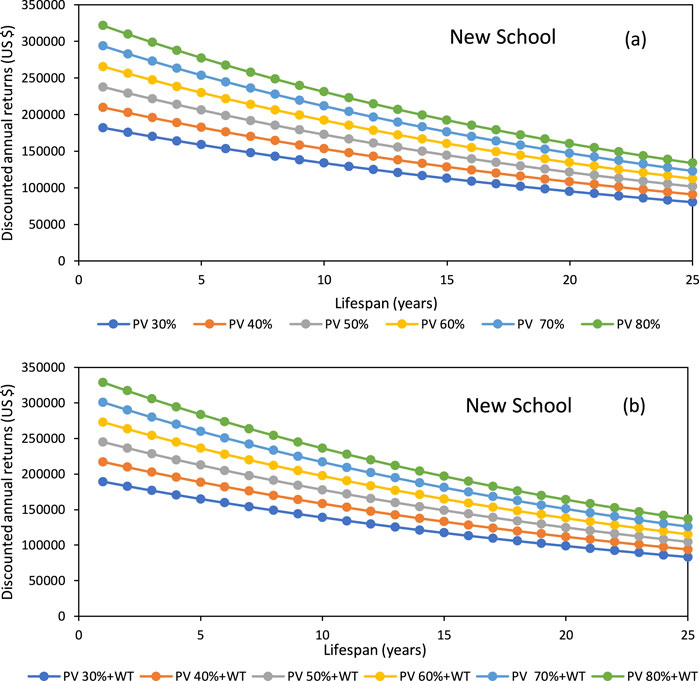
Figure 8. Annual discounted cash returns resulted from renewable energy for new school with rooftop PV only (A), and rooftop PV with WT (B).
Figure 8A shows the annual discounted cash returns from installing rooftop PV panels at various percentages of Roof’s area. It is evident that the economic performance of each installation scenario is homogeneous at the entire study plan (25 years), with superiority of the highest installation area (80% roof), which can attain US$ 330, 000, downward to the lowest installation area (30% roof), with US$ 175,000, at the end of first year. The high installation areas acquire high annual returns despite the decline in PV performance which take place until the last year of the life span, combining to that, the resulted discounted annual returns are also affected by the annual operation and maintenance cost which represents 1% from the capital investment. All other installation scenarios behave in the same manner during the lifespan. On the other hand, adding WT to assist rooftop PV, Figure 8B, has no significant impact on the discounted annual returns at high rooftop PV installation areas, since the installed capacity of WT represents about 5% from the total installed capacity of rooftop at 80% roof’s area. However, the installed WT capacity is about 12% from the installed capacity of rooftop PV at 30% roof’s area. For this reason, the discounted annual returns are marginally higher if the proposed WT is added to rooftop PV installations at smaller areas. From Figure 8B, the configuration of PV at 30% assisted by WT can attain about US$ 195, 000 at the end of first year.
Considering the retrofitted school case, the effect of degradation on the discounted annual returns is shown in Figure 9A with rooftop PV only, and Figure 9B with rooftop PV and WT. Both renewable energy installation scenarios in retrofitted case act similarly to what happened to the new school, although, the discounted annual returns are significantly lower than the new school due to the difference in energy demand between the two cases, which makes the new school a profitable choice under the same size of installed on-site renewable energy choices.
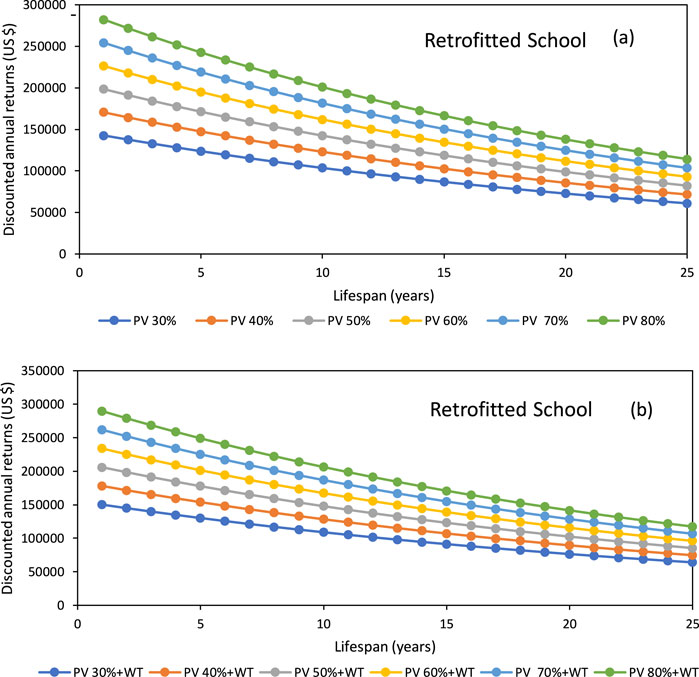
Figure 9. Annual discounted cash returns resulted from renewable energy for retrofitted school with rooftop PV only (A), and rooftop PV with WT (B).
3.3.2 Net present value and discounted payback
The economic performance of the suggested schemes was represented by both net present value (NPV) and discounted payback period (DPP). They represent decision tools that give the decision maker a holistic understanding of the feasibility of the undertaken improvement choices. The NPV and DPP for the integrated improvement choices with on-site renewable energy production are calculated for a 25-year financial plan, as listed in Table 11, considering various rooftop PV installation areas. From Table 11, both school cases have positive returns with the examined on-site renewable energy installation schemes, and they achieved their payback periods within the study period (25-year-plan). In the option of rooftop PV only, the retrofitted school can lower the payback period if the suggested retrofitting choices are combined with a larger rooftop PV installation area. The retrofitted school in this regard has a payback period ranging from 6.36 years at 30% roof PV scenario downward to 5.54 years at 80% roof PV scenario. This was justified by the ability of the school to achieve a greater amount of avoided energy cost at high PV installations that can compensate for the high retrofitting cost. The schools’ owners, as described earlier in Tables 5, 6, have obligations to pay extra cash on the embedded budget to modify the design of the baseline school to adopt the suggested changes. Hence, the extra cash associated with retrofitting was estimated to be around US$ 445,000; while the extra cash related to the new school was estimated to be US$ 96,766.
For this reason, the new school’s economic performance is much better than the retrofitted school because of the lower improvement cost to be paid to modify the baseline design, additionally it was able to conserve more energy requirements annually. The new school’s payback period ranges from 2.78 years at a 30% PV scenario to 3.55 years at an 80% PV scenario. For the fulfillment of NZEB, the retrofitted school under the suggested improvements can achieve its energy balance at 80% rooftop area at NPV of US$ 3,273,000, while the new school can do so at 70% and 80% rooftop PV installations, resulting in NPV of US$ 3,951,000 and US $ 4,284,000 respectively.
On the other hand, adding WT with a small capacity (49.6 kW) has made a slight rise in the resulting DPP. It marginally enhanced the NPV for the studied cases and led to the occurrence of NZEB for the new school at 60% rooftop PV installation. The added WT power represents 12.6% of the installed power of 30% rooftop PV, 9.6% of 40% rooftop PV, 7.7% of 50% rooftop PV, 6.4% of 60% rooftop PV, 5.5% of 70% rooftop PV, and finally 4.8% of 80% rooftop PV. The sensitivity of this added amount was measured against the increase in DPP from each rooftop PV installation. From Table 11, taking new school as an example, the DPP at 30% rooftop is 2.78 years, while the DPP at 30% rooftop combined with WT is 3.31 years, which results in a 19% rise in the breakeven time. Furthermore, the new school has a lower breakeven year at 40% rooftop PV with a DPP value of 3.01. So, from a practical point of view, reallocating the budget of WT to add more PV panels is recommended.
3.4 Projection of environmental and financial benefits
The estimated savings in electrical power can potentially benefit the existing governmental and private schools in the country, which are 979 schools and 296 schools respectively. The electrical savings for these schools are estimated based on savings that were obtained by the retrofitted school. On the other hand, estimated savings for new school is assumed to be applied for new project in Sabah Alhmad City, where a plan to build 170 school was declared by 2033. A comprehensive projection overview for the estimated savings in annual electrical power and the avoided CO2 emissions is shown in Figure 10.
Moreover, the estimated CO2 emissions savings attributed by applying the scenario of 80% PV roof for 25 years period is estimated to be 29.23 Kiloton CO2/school. Projection of the avoided CO2 emissions considering the number of benefited schools which are 1,445 schools is estimated to be 42,237 Kiloton of CO2 during the lifetime of the proposed rooftop PV system.
4 Summary and conclusion
There has been increasing interest in net zero energy buildings (NZEB) in recent years, and many developed countries have enacted legislation that requires the conversion of buildings to make them consume less energy. However, there are considerable concerns about the ability of buildings in hot climate regions to actively be NZEB. Therefore, this work demonstrated a systematic approach to convert the predominant school design in Kuwait to be NZEB. This was achieved by applying several energy conservation measures in order to provide the requirements of NZEB. First, we must study the building model of the existing school, which represents the predominant construction style in Kuwait, and we must verify its ability to adapt NZEB under a retrofitting scheme. Second, suggesting comprehensive enhancement measures and technologies to enable the new schools to act better concerning NZEB. The suggested enhancement parameters covered the better window glazing type with smaller WWR by installing overhang and side fins, installing a VRF split direct-expansion system, installing LED lighting, and ensuring the smart operation of the building. Three cases for the analysis were considered, and the first was a baseline case, i.e., a school building that meets the requirements of Kuwait’s energy code. The second case represented the existing school that incorporated the applicable energy conservation improvements under the retrofitting scheme to meet NZEB. The third case represented the new school to be built in the future, which incorporated the entire energy conservation improvements to meet NZEB. All cases were prepared using DesignBuilder Building Thermal Simulation, and their resulting electrical loads were balanced against the requirements of NZEB by suggested on-site, renewable, energy resources that included rooftop PV at various roofs’ areas, and wind turbines. Based on the techno-economic evaluation of the simulated cases and the results reported in this work, the following conclusions were drawn.
• Applying the academic calendar can reduce the annual electrical load of the baseline school drastically by avoiding the use of the AC during the hot summer months. This has reduced the annual energy demand from 4,900 MWh to 2,200 MWh.
• Schools in hot climates have great potential to actively being NZEB due to their flexibility to be vacant during summer holidays, and by having large roof areas that can accommodate large numbers of renewable energy systems that can be installed on-site.
• A new school could adopt more energy conservation measures at lower cost compared to retrofitting an old school, which requires additional retrofitting costs.
• The performed economic evaluation, under the same on-site renewable energy capacities between new and retrofitted schools, proved that a new school can reach the nearest breakeven year compared to a retrofitted school.
• Despite their abilities to acquire positive returns in present value, the effect of smaller renewable energy capacitates cannot fulfill the recruitments of NZEB.
• The retrofitted school has NPV ranges between 1,610 and 3,273 thousand of US dollars for rooftop insulations between 30% and 80% of the roof’s area, and with the occurrence of NZEB at 80% of the roof’s area.
• The new school has NPV values that range between 2,621 thousand and 4,284 thousand U.S. dollars for rooftop insulations between (30–80)% of the area of the roofs and with the occurrence of NZEB at 70% of the area of the roof and 80% of the area of the roof.
• Adding wind turbines was beneficial in terms of balancing the load against NZEB for the smaller roof areas of PV installations, but it leads to a longer breakeven year compared to NZEB with rooftop PV only.
• The scenario of installing rooftop PV at 80% of the area of the roof is promising in terms of the electrical power that is saved and the subsequent CO2 emissions that are avoided, which are estimated to be 40.63 GWh and 29.23 Tons of CO2, within 25 years for each school.
• By applying energy conservation measures, the estimated annual savings are 589 GWh for the existing 1,275 schools in the retrofitting scheme, and 130 GWh for 170 new schools.
• The scenarios involving the installation of high rooftops have dominance over smaller rooftop installation areas in terms of making NZEB successful and acquiring higher annual profits. The superiority of the scenarios involving high PV installation areas is significant during the lifetime of the PV system despite the effect of the high annual maintenance cost of the large PV installation.
• From the economic and environmental prospectives, the results presented in this work should encourage owners and policymakers to convert existing and new school buildings into NZEB.
• A detailed framework should be developed for each hot climate country to establish a systematic approach that considers the characteristics of school’s building design, the predominant active and passive measures that suit the weather conditions, and energy policies that can encourage the transition toward NZEB.
Data availability statement
The original contributions presented in the study are included in the article/supplementary material, further inquiries can be directed to the corresponding author.
Author contributions
HA: Conceptualization, Data curation, Formal Analysis, Investigation, Methodology, Project administration, Resources, Software, Supervision, Validation, Visualization, Writing–original draft, Writing–review and editing. JA: Conceptualization, Data curation, Methodology, Project administration, Writing–original draft, Writing–review and editing. AEA: Formal Analysis, Investigation, Methodology, Writing–original draft, Writing–review and editing. ASA: Methodology, Project administration, Resources, Supervision, Writing–original draft, Writing–review and editing.
Funding
The author(s) declare that no financial support was received for the research, authorship, and/or publication of this article.
Conflict of interest
The authors declare that the research was conducted in the absence of any commercial or financial relationships that could be construed as a potential conflict of interest.
Generative AI statement
The author(s) declare that no Gen AI was used in the creation of this manuscript.
Publisher’s note
All claims expressed in this article are solely those of the authors and do not necessarily represent those of their affiliated organizations, or those of the publisher, the editors and the reviewers. Any product that may be evaluated in this article, or claim that may be made by its manufacturer, is not guaranteed or endorsed by the publisher.
References
Aelenei, L., Aelenei, D., Gonçalves, H., Lollini, R., Musall, E., Scognamiglio, A., et al. (2013). Design issues for net zero-energy buildings. Open House Int. 38 (3), 7–14. doi:10.1108/OHI-03-2013-B0002
Ahmed, A., Ge, T., Peng, J., Yan, W.-C., Tee, B. T., and You, S. (2022). Assessment of the renewable energy generation towards net-zero energy buildings: a review. Energy Build. 256, 111755. doi:10.1016/j.enbuild.2021.111755
Alajmi, A., Abou-Ziyan, H., and Al-Mutairi, H. H. (2022). Reassessment of fenestration characteristics for residential buildings in hot climates: energy and economic analysis. Front. Energy 16 (4), 629–650. doi:10.1007/s11708-021-0799-z
AlAjmi, A., Abou-Ziyan, H., and Ghoneim, A. (2016a). Achieving annual and monthly net-zero energy of existing building in hot climate. Appl. Energy 165, 511–521. doi:10.1016/j.apenergy.2015.11.073
AlAjmi, A., Abou-Ziyan, H., and Ghoneim, A. (2016b). Achieving annual and monthly net-zero energy of existing building in hot climate. Appl. Energy 165, 511–521. doi:10.1016/j.apenergy.2015.11.073
Alajmi, A., and Zedan, M. (2020). Energy, cost, and environmental analysis of individuals and district cooling systems for a new residential city. Sustain. Cities Soc. 54, 101976. doi:10.1016/j.scs.2019.101976
Al-Awadi, H., Alajmi, A., and Abou-Ziyan, H. (2022). Effect of thermal bridges of different external wall types on the thermal performance of residential building envelope in a hot climate. Buildings 12 (3), 312. doi:10.3390/buildings12030312
Ali, H., and Hashlamun, R. (2019). Envelope retrofitting strategies for public school buildings in Jordan. J. Build. Eng. 25 (5), 100819. doi:10.1016/j.jobe.2019.100819
Alkhateeb, E., and Abu-Hijleh, B. (2019). Potential for retrofitting a federal building in the UAE to net zero electricity building (nZEB). Heliyon 5 (6), e01971. doi:10.1016/j.heliyon.2019.e01971
Allison, T. (1979). Heat gains in Kuwait buildings: a simplified code (kisr -PPI/110 ENG-PT-G-7931). Kuwait Institute for Scientific Research.
Almutairi, H. (2012). Low energy air conditioning for hot climates [Doctoral dissertation, the University of Manchester]. The University of Manchester. Available at: https://pure.manchester.ac.uk/ws/portalfiles/portal/54519813/FULL_TEXT.PDF.
Al-Mutairi, H., Dewsbury, J., and Lane-Serff, G. F. (2011). Energy and the implication of residential cooling in hot climates: a case study for developing an effective solution for residential cooling energy demand in Kuwait. WIT Trans. Ecol. Environ. 150, 859–870. doi:10.2495/SDP110711
Almutairi, H. H., Alajmi, A., and Ahmed, N. A. (2022). A techno-economic analysis of PV solar modules attached to vertical facades of a residential building in a hot arid climate. J. Eng. Res. 10 (3B). doi:10.36909/jer.16407
Almutairi, H. H., Dewsbury, J., and Lane-Serff, G. F. (2015). “Lifecycle cost analysis for better air conditioning choice in Kuwait residential sector,” in Proceedings of the ASME international mechanical engineering congress and exposition, 6B. Texas, United States: Energy. doi:10.1115/IMECE2015-53161
Al-Nassar, W. K., Neelamani, S., and William, T. S. (2021). “Economic feasibility of wind and photovoltaic energy in Kuwait,”, 280. E3S Web of Conferences: EDP Sciences. doi:10.1051/e3sconf/202128005016
Al-Saeed, Y. W., and Ahmed, A. (2018). Evaluating design strategies for nearly zero energy buildings in the middle east and North Africa regions. Designs 2 (4), 35. doi:10.3390/designs2040035
Al-Temeemi, A. S. (1995). Climatic design techniques for reducing cooling energy consumption in Kuwaiti houses. Energy Build. 23 (1), 41–48. doi:10.1016/0378-7788(95)00915-K
Anju, M. S. (2017). Comparison of cost and energy efficiencies of zero energy residential building and conventional building. Int. J. Eng. Sci. Invent. 6 (7), 64–71.
Arif, S., Taweekun, J., Ali, H. M., Yanjun, D. A. I., and Ahmed, A. (2021). Feasibility study and economic analysis of grid connected solar powered net zero energy building (NZEB) of shopping mall for two different climates of Pakistan and Thailand. Case Stud. Therm. Eng. 26, 101049. doi:10.1016/j.csite.2021.101049
Carbone free heat (2023), Available at: https://carbonfreeheat.com/10kw-wind-turbine-on-off-grid-usa. (Accessed 2023, November 20).
Directive (2010). Directive 2010/31/EU of the European Parliament and of the Council of 19 May 2010 on the energy performance of buildings (recast). Official J. Eur. Union.
Directive (2018). 2018/844/EU of the European Parliament and of the council of 19 June 2018 on the energy performance of buildings (recast). Official J. Eur. Communities 61 (156), 75–91.
Espejel-Blanco, D. F., Hoyo-Montano, J. A., Orrante-Sakanassi, J. A., and Federico-Rivera, J. A. (2018). “Comparison of energy consumption of fluorescent vs LED lighting system of an academic building,” in Proceedings of 2018 IEEE conference on technologies for sustainability, 1–6.
Feng, W., Zhang, Q., Ji, H., Wang, R., Zhou, N., Ye, Q., et al. (2019). A review of net zero energy buildings in hot and humid climates: experience learned from 34 case study buildings. Renew. Sustain. Energy Rev. 114 (C), 109303. doi:10.1016/j.rser.2019.109303
GamalEldine, M., and Corvacho, H. (2022). Compliance with building energy code for the residential sector in Egyptian hot-arid climate: potential impact, difficulties, and further improvements. Sustainability 14 (7), 3936. doi:10.3390/su14073936
Gorse, C. (2020). Building performance and measurement: its place within a variable climate. Int. J. Build. Pathology Adapt. 38 (1), 1–2. doi:10.1108/IJBPA-02-2020-111
Hajiah, A. E., Alghimlas, F., and Maheshwari, G. P. (2006). “Suitability of district cooling for Kuwait,” in Proceedings of 10th international symposium on district heating and cooling.
Harkouss, F., Fardoun, F., and Biwole, P. H. (2018b). Multi-objective optimization methodology for net zero energy buildings. J. Build. Eng. 16, 57–71. doi:10.1016/j.jobe.2017.12.003
Harkouss, F., Fardoun, F., and Pascal Henry Biwole, P. H. (2018a). Optimization approaches and climates investigations in NZEB—a review. Build. Simul. 11, 923–952. doi:10.1007/s12273-018-0448-6
Johnston, D., and Gibson, S. (2010). Toward a zero energy home: a complete guide to energy self-sufficiency at home. Taunton Press.
Kolokotsa, D., Rovas, D., Kosmatopoulos, E., and Kalaitzakis, K. (2011). A roadmap towards intelligent net zero – and positive energy buildings. Sol. Energy 85 (12), 3067–3084. doi:10.1016/j.solener.2010.09.001
Krarti, M., and Dubey, K. (2017). Energy productivity evaluation of large scale building energy efficiency programs for Oman. Sustain. Cities Soc. 29, 12–22. doi:10.1016/j.scs.2016.11.009
Krarti, M., Dubey, K., and Howarth, N. (2017). Evaluation of building energy efficiency investment options for the Kingdom of Saudi Arabia. Energy 134, 595–610. doi:10.1016/j.energy.2017.05.084
Kurnitski, J., Buso, T., Corgnati, S. P., Derjanecz, A., and Litiu, A. V. (2014). nZEB definitions in Europe. REHVA J. 51 (2), 6–9.
Li, X., Wu, W., and Yu, C. W. F. (2015). Energy demand for hot water supply for indoor environments: problems and perspectives. Indoor Built Environ. 24 (1), 5–10. doi:10.1177/1420326X14564285
Mathew, M. S., Kandukuri, S. T., and Omlin, C. W. (2022). Estimation of wind turbine performance degradation with deep neural networks. PHM Soc. Eur. Conf. 7 (1), 351–359. doi:10.36001/phme.2022.v7i1.3328
Ministry of Electricity and Water of Kuwait. (2019). Energy conservation code of practice (MEW/R-6/2018).
Paoletti, G., Pascual Pascuas, R., Pernetti, R., and Lollini, R. (2017). Nearly zero energy buildings: an overview of the main construction features across Europe. Buildings 7 (2), 43. doi:10.3390/buildings7020043
Park, J., Kim, T., and Lee, C.-s. (2019). Development of thermal comfort-based controller and potential reduction of the cooling energy consumption of a residential building in Kuwait. Energies 12 (17), 3348. doi:10.3390/en12173348
Pervez, H., Ali, Y., and Petrillo, A. (2021). A quantitative assessment of greenhouse gas (GHG) emissions from conventional and modular construction: a case of developing country. J. Clean. Prod. 294, 126210. doi:10.1016/j.jclepro.2021.126210
Pless, S., Scheib, J., Torcellini, P., and Slovensky, M. (2014). NASA net zero energy buildings roadmap. doi:10.2172/115938
Rana, M. J., Hasan, M. R., Sobuz, M. H. R., and Sutan, N. M. (2021). Evaluation of passive design strategies to achieve NZEB in the corporate facilities: the context of Bangladeshi subtropical monsoon climate. Int. J. Build. Pathology Adapt. 39 (4), 619–654. doi:10.1108/IJBPA-05-2020-0037
RESDM (2023). Analyze wind farms worldwide. Available at: https://resdm.com/wind-farms-analyzer (Accessed September 28, 2023).
Sartori, I., Napolitano, A., and Voss, K. (2012). Net zero energy buildings: a consistent definition framework. Energy Build. 48, 220–232. doi:10.1016/j.enbuild.2012.01.032
Silva, S. M., Mateus, R., Marques, L., Ramos, M., and Almeida, M. (2016). Contribution of the solar systems to the nZEB and ZEB design concept in Portugal–Energy, economics and environmental life cycle analysis. Sol. Energy Mater. Sol. Cells 156, 59–74. doi:10.1016/j.solmat.2016.04.053
Stephens, B. (2011). Modeling a net-zero energy residence: combining passive and active design strategies in six climates. ASHRAE Trans. 117 (1), 381+. Available at: https://link.gale.com/apps/doc/A257557820/AONE?u=anon∼69c698b4&sid=googleScholar&xid=7c128056.
Valasai, G. D., Uqaili, M. A., Memon, H. U. R., Samoo, S. R., Mirjat, N. H., and Harijan, K. (2017). Overcoming electricity crisis in Pakistan: a review of sustainable electricity options. Renew. Sustain. Energy Rev. 72, 734–745. doi:10.1016/j.rser.2017.01.097
Webb, N. P., Marshall, N. A., Stringer, L. C., Reed, M. S., Chappell, A., and Herrick, J. E. (2017). Land degradation and climate change: building climate resilience in agriculture. Front. Ecol. Environ. 15 (8), 450–459. doi:10.1002/fee.1530
Wells, L., Rismanchi, B., and Aye, L. (2018). A review of net zero energy buildings with reflections on the Australian context. Energy Build. 158, 616–628. doi:10.1016/j.enbuild.2017.10.055
Yousuf, I., Ghumman, A. R., Hashmi, H. N., and Kamal, M. A. (2014). Carbon emissions from power sector in Pakistan and opportunities to mitigate those. Renew. Sustain. Energy Rev. 34, 71–77. doi:10.1016/j.rser.2014.03.003
ZEUS (2023). Wind turbine. Available at: https://www.tesup.co.uk/product-page/zeus3-wind-turbine-generator-12v-24v-48v-3kw-amazon-ebay-united-kingdom (Accessed October 4, 2023).
Keywords: NZEB, hot climate, present value, discounted payback, avoided CO2
Citation: Almutairi HH, Almutairi JH, Alhashem AE and Almutairi AS (2024) The potential of NZEB for existing and prospective school buildings by applying energy conservation measures and efficient technologies suitable for hot arid climate. Front. Energy Res. 12:1503382. doi: 10.3389/fenrg.2024.1503382
Received: 28 September 2024; Accepted: 04 November 2024;
Published: 19 December 2024.
Edited by:
Mostafa Esmaeili Shayan, University of Cagliari, ItalyReviewed by:
Mohammad Reza Hayati, Islamic Azad University Semnan, IranAli Fguiri, Gabes University, Tunisia
Copyright © 2024 Almutairi, Almutairi, Alhashem and Almutairi. This is an open-access article distributed under the terms of the Creative Commons Attribution License (CC BY). The use, distribution or reproduction in other forums is permitted, provided the original author(s) and the copyright owner(s) are credited and that the original publication in this journal is cited, in accordance with accepted academic practice. No use, distribution or reproduction is permitted which does not comply with these terms.
*Correspondence: Hamad H. Almutairi, aGhoLmFsbXV0YWlyaUBwYWFldC5lZHUua3c=
 Hamad H. Almutairi*
Hamad H. Almutairi* Jaber H. Almutairi
Jaber H. Almutairi